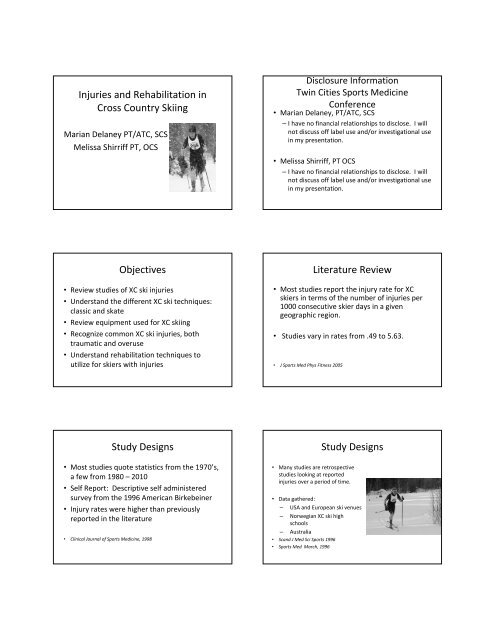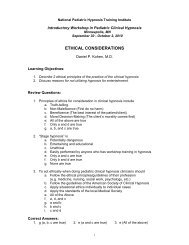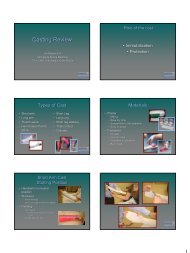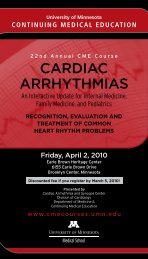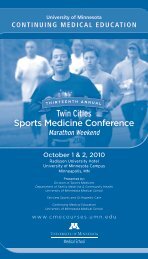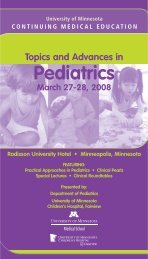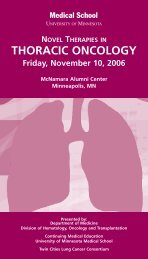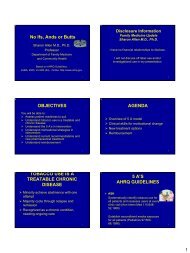Injuries and Rehabilitation in Cross Country Skiing Objectives ...
Injuries and Rehabilitation in Cross Country Skiing Objectives ...
Injuries and Rehabilitation in Cross Country Skiing Objectives ...
Create successful ePaper yourself
Turn your PDF publications into a flip-book with our unique Google optimized e-Paper software.
<strong>Injuries</strong> <strong>and</strong> <strong>Rehabilitation</strong> <strong>in</strong><br />
<strong>Cross</strong> <strong>Country</strong> Ski<strong>in</strong>g<br />
Marian Delaney PT/ATC, SCS<br />
Melissa Shirriff PT, OCS<br />
Disclosure Information<br />
Tw<strong>in</strong> Cities Sports Medic<strong>in</strong>e<br />
Conference<br />
• Marian Delaney, PT/ATC, SCS<br />
– I have no f<strong>in</strong>ancial relationships to disclose. I will<br />
not discuss off label use <strong>and</strong>/or <strong>in</strong>vestigational use<br />
<strong>in</strong> my presentation.<br />
• Melissa Shirriff, PT OCS<br />
– I have no f<strong>in</strong>ancial relationships to disclose. I will<br />
not discuss off label use <strong>and</strong>/or <strong>in</strong>vestigational use<br />
<strong>in</strong> my presentation.<br />
<strong>Objectives</strong><br />
• Review studies of XC ski <strong>in</strong>juries<br />
• Underst<strong>and</strong> the different XC ski techniques:<br />
classic <strong>and</strong> skate<br />
• Review equipment used for XC ski<strong>in</strong>g<br />
• Recognize common XC ski <strong>in</strong>juries, both<br />
traumatic <strong>and</strong> overuse<br />
• Underst<strong>and</strong> rehabilitation techniques to<br />
utilize for skiers with <strong>in</strong>juries<br />
Literature Review<br />
• Most studies report the <strong>in</strong>jury rate for XC<br />
skiers <strong>in</strong> terms of the number of <strong>in</strong>juries per<br />
1000 consecutive skier days <strong>in</strong> a given<br />
geographic region.<br />
• Studies vary <strong>in</strong> rates from .49 to 5.63.<br />
• J Sports Med Phys Fitness 2005<br />
Study Designs<br />
• Most studies quote statistics from the 1970’s,<br />
a few from 1980 –2010<br />
• Self Report: Descriptive self adm<strong>in</strong>istered<br />
survey from the 1996 American Birkebe<strong>in</strong>er<br />
• Injury rates were higher than previously<br />
reported <strong>in</strong> the literature<br />
• Cl<strong>in</strong>ical Journal of Sports Medic<strong>in</strong>e, 1998<br />
Study Designs<br />
• Many studies are retrospective<br />
studies look<strong>in</strong>g at reported<br />
<strong>in</strong>juries over a period of time.<br />
• Data gathered:<br />
– USA <strong>and</strong> European ski venues<br />
– Norwegian XC ski high<br />
schools<br />
– Australia<br />
• Sc<strong>and</strong> J Med Sci Sports 1996<br />
• Sports Med March, 1996
Ski Technique<br />
• Classic or diagonal stride<br />
– Historically the predom<strong>in</strong>ant technique<br />
– Noted to be used by Norwegian Birkebe<strong>in</strong>ers <strong>in</strong><br />
the 1200’s<br />
• Skate<br />
– Developed <strong>in</strong> the mid 1980’s<br />
Classic<br />
• Both skis are po<strong>in</strong>ted straight ahead<br />
• Skis <strong>in</strong> a track<br />
• Pol<strong>in</strong>g technique<br />
– S<strong>in</strong>gle stick<br />
– Double pole<br />
Skate<br />
• Legs are alternately pushed out to the side <strong>in</strong><br />
a skat<strong>in</strong>g technique<br />
– V1, V2, <strong>and</strong> V2 alternate describe different skat<strong>in</strong>g<br />
technique<br />
• Pol<strong>in</strong>g technique differs<br />
– Poles are used <strong>in</strong> different<br />
planes<br />
Equipment<br />
• Classic skis<br />
– Longer skis<br />
– Kick box for kick wax<br />
– Wax less skis don’t require kick wax<br />
• Poles<br />
– Shorter, to the top of the<br />
of the shoulder<br />
• Skate Skis<br />
– Shorter<br />
– no kick box<br />
– Waxed for glide only<br />
• Poles<br />
– Longer, to the bottom<br />
of the ch<strong>in</strong><br />
Equipment<br />
• Traumatic<br />
– Lower Extremity<br />
• Medial Collateral<br />
Ligament Spra<strong>in</strong>s<br />
• ACL <strong>and</strong> meniscal<br />
<strong>in</strong>juries<br />
• Ankle <strong>in</strong>version<br />
<strong>in</strong>juries<br />
• Fractures<br />
<strong>Injuries</strong>
<strong>Injuries</strong><br />
• Traumatic<br />
– Upper Extremity<br />
• Fractures of the shoulder, wrist <strong>and</strong> thumb<br />
• Skier’s thumb: spra<strong>in</strong> of the ulnar collateral<br />
ligament<br />
• AC spra<strong>in</strong>s<br />
• Shoulder dislocations<br />
Speeds with skat<strong>in</strong>g techniques on a downhill can<br />
reach up to 50 mph.<br />
<strong>Injuries</strong><br />
The repetitive nature of XC<br />
techniques makes skiers<br />
susceptible to overuse <strong>in</strong>juries<br />
– Low back<br />
– Patellafemoral<br />
– Shoulder<br />
Low Back Pa<strong>in</strong><br />
• Contribut<strong>in</strong>g Factors<br />
– Classic ski<strong>in</strong>g techniques <strong>in</strong>duces back pa<strong>in</strong> to a<br />
greater degree than skat<strong>in</strong>g.<br />
• Static load on the erector sp<strong>in</strong>ae<br />
• Double pol<strong>in</strong>g <strong>in</strong>duced twice as much pa<strong>in</strong> <strong>in</strong> females<br />
than males<br />
• May be caused by greater trunk muscular weakness <strong>in</strong><br />
females<br />
• Hip weakness<br />
‐Trendelenberg<br />
‐Gluteal<br />
strengthen<strong>in</strong>g<br />
Low Back Rehab<br />
Sc<strong>and</strong> J Med Sci Sports 1996<br />
Normal Strength<br />
Trendelenberg
Gluteal Strengthen<strong>in</strong>g<br />
• Bridg<strong>in</strong>g<br />
• Side ly<strong>in</strong>g abduction<br />
• Step downs<br />
• B<strong>and</strong> walks<br />
Exercise Frequency<br />
• Repetitions <strong>and</strong> frequency of perform<strong>in</strong>g the<br />
exercises is dependent on the severity of the<br />
<strong>in</strong>jury or if the exercises are be<strong>in</strong>g performed for<br />
prevention.<br />
• 3 sets of 15 reps to fatigue performed 2X a week<br />
is recommended <strong>in</strong> the build<strong>in</strong>g phase of tra<strong>in</strong><strong>in</strong>g.<br />
• One session a week is recommended for<br />
ma<strong>in</strong>tenance dur<strong>in</strong>g the season.<br />
Bridg<strong>in</strong>g<br />
Side Ly<strong>in</strong>g Abduction<br />
Step Downs<br />
B<strong>and</strong> Walks
Core Issues<br />
• Abdom<strong>in</strong>al strength<br />
• Back Extensor endurance<br />
• Planks<br />
– Prone<br />
– Side ly<strong>in</strong>g<br />
Trunk Strengthen<strong>in</strong>g<br />
• Hip Flexor length<br />
Trunk Strengthen<strong>in</strong>g<br />
Abdom<strong>in</strong>al Strengthen<strong>in</strong>g<br />
Back Extension<br />
Back Extension
Hip Flexor Stretch<br />
Technique<br />
Patellafemoral Pa<strong>in</strong><br />
• Knee valgus position<br />
– Poor track<strong>in</strong>g of patella<br />
– Weakness of the hips<br />
– Foot <strong>and</strong> ankle<br />
<strong>in</strong>fluences<br />
– Technique<br />
Patellafemoral Pa<strong>in</strong><br />
• Hip strengthen<strong>in</strong>g<br />
– Exercises from LBP<br />
– Side ly<strong>in</strong>g ER<br />
• Clams<br />
– Dynamic control<br />
• Lunge variations<br />
• S<strong>in</strong>gle leg dead lifts<br />
Hip strength<br />
Lunges<br />
ER strength<br />
Clams
S<strong>in</strong>gle leg dead lifts<br />
Technique<br />
• Knee valgus<br />
• Poor weight shift<br />
• Foot/Ankle position<br />
Valgus Knee ‐ Classic<br />
Good Alignment ‐ Skate<br />
Valgus Knee ‐ Skate<br />
Shoulder Pa<strong>in</strong><br />
• Postural <strong>in</strong>fluences<br />
– Forward head<br />
– Rounded shoulders<br />
– Thoracic kyphosis
Good Position<br />
Poor Position<br />
Poor Position<br />
Shoulder Pa<strong>in</strong><br />
• Imp<strong>in</strong>gements<br />
– Rotator cuff weakness<br />
– Scapular dysfunction<br />
– Technique<br />
• Skat<strong>in</strong>g pol<strong>in</strong>g off one side<br />
predom<strong>in</strong>antly<br />
• Lack of trunk compression<br />
– Equipment<br />
• Pole length<br />
Strengthen<strong>in</strong>g<br />
External Rotation<br />
Include cuff <strong>and</strong> scapular exercises<br />
• External Rotators<br />
• Scaption<br />
• Row<strong>in</strong>g<br />
• Horizontal Abduction<br />
• Extension
Scaption<br />
Row<strong>in</strong>g<br />
Horizontal Abduction<br />
Extension<br />
Flexibility<br />
Pectoral Stretch<br />
• Thoracic<br />
extension<br />
• Pectoralis<br />
stretch
Prevention <strong>and</strong> Safety<br />
• Off season tra<strong>in</strong><strong>in</strong>g<br />
• Proper warm up<br />
• Ski <strong>in</strong>struction <strong>and</strong> coach<strong>in</strong>g<br />
• Snow conditions <strong>and</strong> terra<strong>in</strong><br />
– www.sk<strong>in</strong>nyski.com<br />
– Three Rivers Park District ski hotl<strong>in</strong>e: 763‐559‐6778<br />
• Professional advice when choos<strong>in</strong>g equipment<br />
• Proper eye protection<br />
• Cloth<strong>in</strong>g<br />
In Summary<br />
• Utilize <strong>in</strong>formation about technique to help<br />
underst<strong>and</strong> a skier’s <strong>in</strong>jury history<br />
• Select the appropriate exercises<br />
• Work with coaches on proper technique<br />
The End


